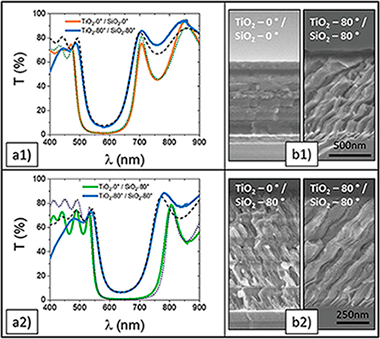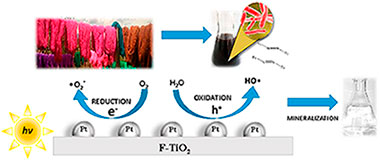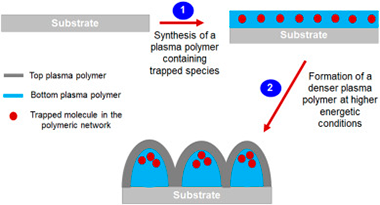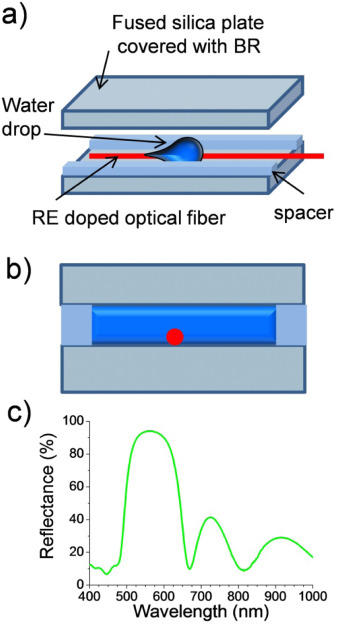Artículos SCI
2019
2019
Nanotecnología en Superficies y Plasma
Environmentally Tight TiO2-SiO2 Porous 1D-Photonic Structures
Garcia-Valenzuela, A; Lopez-Santos, C; Rico, V; Alvarez, R; Palmero, A; Gonzalez-Elipe, ARAdvanced Materials Interfaces, 6 (2019) art. 1801212
Show abstract ▽

Although thin film porosity is the basis of many optical sensors, it can be deleterious for a stable optical behavior of passive optical elements due to the condensation of water and other vapors in their pores. This paper proposes a new strategy for the magnetron sputtering (MS) fabrication of environmentally tight SiO2-TiO2 porous multilayers. Thin films of these two oxides deposited in an oblique angle configuration (MS-OAD) present a nanocolumnar and highly porous nanostructure and, as a consequence, experience significant changes in their optical properties when exposed to water vapor. Similarly, the optical properties of Bragg reflectors and Bragg microcavities made of the stacking of porous and compact SiO2 and TiO2 thin films experience reversible changes when these 1D-photonic structures are exposed to water pressure. A key finding of this work is that a very thin capping layer of SiO2 deposited on the surface of porous SiO2 films in the stack, at the interlayer between the two oxides, efficiently seals the pores making the photonic structures environmentally tight. This capping layer approach is a useful strategy to incorporate porosity as an additional parameter to design the optical behavior of planar photonic structures while preserving optical and environmental stability.
Febrero, 2019 | DOI: 10.1002/admi.201801212
Reactividad de Sólidos
Production of Ag-ZnO powders by hot mechanochemical processing
Guzman, D; Aguilar, C; Rojas, P; Criado, JM; Dianez, MJ; Espinoza, R; Guzman, A; Martinez, CTransactions of nonferrous metals society of China, 29 (2019) 365-373
Show abstract ▽
Ag-CdO composites are still one of the most commonly used electrical contact materials in low-voltage applications owing to their excellent electrical and mechanical properties. Nevertheless, considering the restriction on using Cd due to its toxicity, it is necessary to find alternative materials that can replace these composites. In this study, the synthesis of Ag-ZnO alloys from Ag-Zn solid solutions was investigated by hot mechanochemical processing. The hot mechanochemical processing was conducted in a modified attritor mill at 138 degrees C under flowing O-2 at 1200 cm(3)/min for 3.0 h. The microstructure and phase evolution were investigated using X-ray diffractometry, field emission gun scanning electron microscopy and transmission electron microscopy. The results suggest that it is possible to complete the oxidation of Ag-Zn solid solution by hot mechanochemical processing at a low temperature and short time. This novel synthesis route can produce Ag-ZnO composites with a homogeneous distribution of nanoscale ZnO precipitates, which is impossible to achieve using the conventional material processing methods. Considering the fact that the fundamental approach to improving electric contact material performance resides in obtaining uniform dispersion of the second-phase in the Ag matrix, this new processing route could open the possibility for Ag-ZnO composites to replace non-environmentally friendly Ag-CdO.
Febrero, 2019 | DOI: 10.1016/S1003-6326(19)64946-0
Fotocatálisis Heterogénea: Aplicaciones
Fluorinated and Platinized Titania as Effective Materials in the Photocatalytic Treatment of Dyestuffs and Stained Wastewater Coming from Handicrafts Factories
Murcia, J.J.; Cely, A.C.; Rojas, H.A.; Hidalgo, M.C.; Navío, J.A.Catalysts, 9 (2019) 179
Show abstract ▽

In this study, commercial and lab-prepared TiO2 were modified by fluorination and platinum photodeposition; and the effect of these modifications over the physicochemical and photocatalytic properties of TiO2 was evaluated. It was found that F and Pt addition leads to the modification of the optical and textural properties of TiO2. The materials prepared were tested in the photocatalytic degradation of different organic dyestuffs such as methylene blue (MB) and methyl orange (MO); the degradation of commercial anilines employed in the staining of natural fibers was also evaluated. Photocatalysis was also studied in this work as an eco-friendly treatment of wastewater coming from handicrafts factories. In general it was observed that the effectiveness of the photocatalytic treatment strongly depends on the substrate to be degraded, thus, fluorinated and platinized commercial Titania (Pt-F-P25) showed the best photocatalytic performance in the MB and MO photodegradation and in contrast, in the case of the anilines the highest degradation was obtained over commercial TiO2 fluorinated (F-P25). These results can be explained by differences observed in the structure and in the adsorption of these dyestuffs over the photocatalysts surfaces. F-P25 photocatalyst also demonstrated to be the best material for the treatment of real wastewater coming from handicrafts factories.
Febrero, 2019 | DOI: 10.3390/catal9020179
Nanotecnología en Superficies y Plasma
An innovative approach for micro/nano structuring plasma polymer films
Thiry, D; Vinx, N; Aparicio, FJ; Moerman, D; Lazzaroni, R; Cossement, D; Snyders, RThin Solid Films, 672 (2019) 26-32
Show abstract ▽

This work aims at presenting an innovative method for tailoring the morphology of functionalized plasma polymer films (PPF). The approach is based on the formation of a plasma polymer bilayer system in which the two layers differ by their chemical composition and cross-linking degree. As a case study, propanethiol-based plasma polymer films have been investigated. As revealed by a much higher S/C ratio than in the propanethiol precursor (i.e. 0.83 vs 0.33), it has been demonstrated that the bottom layer contains a large fraction of trapped sulfur-based molecules (e.g. H2S). When further covered by a denser PPF formed at higher energetic conditions, a three-dimensional morphological reorganization takes place giving rise to the micro/nano structuration of the organic material. The shape, the dimensions as well as the density of the generated structures are found to depend on the thickness of both coatings involved in the bilayer structure, offering a great flexibility for surface engineering. Annealing experiments unambiguously confirm the major role played by the sulfur-based trapped molecules for inducing the reshaping process. The whole set of data clearly paves the way for the development of an innovative approach for finely tailoring the morphology of functionalized PPF at the micro/nano scale.
Febrero, 2019 | DOI: 10.1016/j.tsf.2018.12.050
Nanotecnología en Superficies y Plasma
Holmium doped fiber thermal sensing based on an optofluidic Fabry-Perot microresonator
Lahoz, F; Martin, IR; Soler-Carracedo, K; Caceres, JM; Gil-Rostra, J; Yubero, FJournal of Luminescence, 206 (2019) 492-497
Show abstract ▽

An optical temperature sensor suitable for label free liquid sensing has been designed and characterized. The sensor combines the photochemical stability of rare earth doped glasses and the high sensitivity of interferometric resonators. It is formed by a planar Eabry-Perot (FP) microcavity filled with the liquid to be monitored. A Ho3+ doped tapered optical fiber has been placed inside the microcavity surrounded by the fluid medium. An external laser is focused on the optical fiber inside the cavity to induce the luminescence of the Ho3+ ions, which couples to the FP optical resonances. The spectral position of the FP resonances is highly sensitive to the refractive index of the cavity medium. A second laser is co-aligned with the first one to locally heat the liquid medium around the optical fiber. An average blue shift of the FP resonances around 32 pm/degrees C is measured. The limit of detection of the laser induced heating of the liquid medium is about 0.3 degrees C in the biological temperature range. Alternatively, a hot-plate is used to heat the system. Interestingly, a red shift of the FP modes is observed with 75 pm/degrees C dependence and 0.12 degrees C limit of detection features.
Febrero, 2019 | DOI: 10.1016/j.jlumin.2018.10.103
- ‹ anterior
- 141 of 420
- siguiente ›














